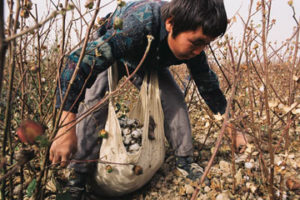
Children in Uzbekistan often pick cotton with bare hands, with sometimes nothing more than slippers or sandals on their feet. © Environmental Justice Foundation
As I’ve written on the subject before, Uzbekistan is one of the worst human rights offenders out there. Recent news of child labor during this fall’s cotton harvesting season once again put the country into the international spotlight drawing sharp criticism by human rights activists. Meanwhile, in the same vein, Bell Pottinger Group’s dealings with the dictatorship was recently revealed and criticized in the news. This firm is a London-based public relations agency and is one of the largest lobbying companies in the U.K.
For the past several years each fall, when the cotton harvesting season in Uzbekistan begins, the news media and human rights groups sound the alarm about children as young as ten years old (reports on this differ) being pulled from school and forced to work the cotton fields. Bear in mind that the Uzbek government bars independent international observers in the country during the harvest season.
This year the story largely remains the same – there was a spike in coverage of this issue starting in September. However, a few positive developments took place this fall:
1) Sixty of the world’s major retailers, including Walmart, Walt Disney, H&M and Adidas agreed to boycott all products known to contain Uzbek cotton. But skepticism remains. According to the Uzbek-German Forum for Human Rights’ Director Niyazova Umida, “such kind of a boycott will not help immediately because there are a lot of other cotton traders – from China, Bangladesh and Pakistan and other Asian countries.”
The situation surrounding forced child labor in the cotton industry remains appalling. I have no way of knowing that the clothes I’m wearing today are not made out of Uzbek cotton which made its way to Bangladesh or somewhere else where it was processed into yarn or sown and later sold to large retailers in Europe or the U.S. and finally found its way to a consumer like me. I know that H&M is one of the companies that made an effort to eliminate cotton from Uzbekistan from its supply chain and this is explicitly stated on their website.
I love Lucky Brand and I especially like their jeans so I decided to check out their website and see if there is any information about the source of their cotton or their social responsibility policy regarding child labor or other unethical practices. I don’t see anything of this sort on their web page. I do see this:
We were born in Southern California and it’s a big part of what we make. We’re inspired by amazing nature, like the orange groves and mountains of Ojai and the beach towns that dot the pacific Coast Highway. We love great music, art and photography – new and old. And we can’t get enough of the casual lifestyle and amazing weather (Who doesn’t like taking a drive with the top down on a 70-degree winter day?). In addition to giving our jeans their distinctive look and vibe, Southern California also inspires our seasonal Lucky Brand fashion collections – jackets, sweaters, dresses, pants and accessories that work with or without your denim.
There’s certainly nothing wrong with this. I too love all those things as I spent a large chunk of my life growing up in So Cal. But while thinking about the ocean breeze and orange groves I had a haunting image of children forced to pick cotton instead of attending school under the scorching Central Asian sun. It doesn’t sit well with me.
I recently went to lunch with a German friend. Somebody complimented her scarf and she said she got it at Primark. I had never heard of the store before so I asked about it and one of her first comments was that it seems like a sweatshop and she doesn’t like it despite the fact that they sell cheap clothes. This reminded me of the sandblasted/distressed jeans story that was making rounds on my Facebook newsfeed shared and reposted by friends. People were appalled by it. Consumers do care and I hope they can make a difference. But without calling attention to this issue chances are nothing will change.
If you’re in Liverpool, the International Slavery Museum is hosting an exhibition White Gold: the True Cost of Cotton until September 2012. The exhibition highlights the abuse of labor rights in the cotton industry primarily focusing on in Uzbekistan.
Boy picking cotton. Photo: Courtesy National Museums Liverpool.
Watch White Gold – the True Cost of Cotton from Environmental Justice:
Other videos about child labor in Uzbekistan worth checking out: Newsnight Investigates the Uzbek Cotton Industry.